FIRST EDIT: Sooz Aug 19
*Question – First paragraph, who/what are the “maui” ? I want to correct this sentence structure to read something like, “… – the same plant that the Maui people use to make tapa cloths”, but I am unsure if this is what is meant by the reference. Please clarify, thanks!
Si Aug 20-please see changes in red.
Si Aug 31: a little Intro is needed. Please revise my draft.
Many puer lovers have been curious about the special cake form. How do those loose leaves being pressed into a cake? and how do they being wrapped? how do the 7-cake bamboo barrel being packaged?
Jen Sauer 9/22/16: Si, good video content. The first one is a little long (6 minutes). As a reader of this article, I’d love to see an opening paragraph that explains that this is an article about the different ways that puer is traditionally wrapped/packaged, from the use of mulberry bark to handmade papers to bamboo.
Article by Chayu editorial team, Chongqing, China
Photos: Ming Li, courtesy of Chayefuxing (cake- and brick-pressing); Sen Chen (papermaking and bamboo bundles)
Cake-pressing
This video shows how puer loose leaves pressed into a cake.
Papermaking
As a traditional household paper in Yunnan, stencil tissue paper is made of the barks of paper mulberry, also known as tapa cloth tree – the same plant that polynesians traditionally employ to make tapa cloths. This species usually grows 10 to 20 meters tall and is pruned back every half year. It will regrow to its normal height, rendering itself a sustainable, natural resource for papermaking. Here is how you make traditional paper from this special mulberry tree.
Production Process
Step 1. Wash harvested barks in the river repeatedly to remove silt. This also softens the barks to prepare for papermaking.
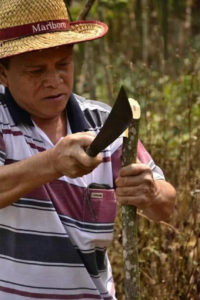
Step 2. Spread and roll the bark sheets. Cook the sheets in large wooden cask with boiling water for 2-3 hours.
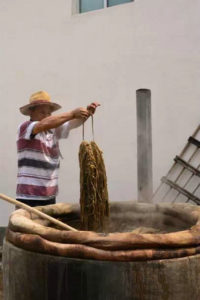
Step 3. Beat boiled barks with a hammer to coagulate and squeeze out pulps, either by hand or by rolling machines. Incidentally, these machines are commonly seen to make wulong tea as well.
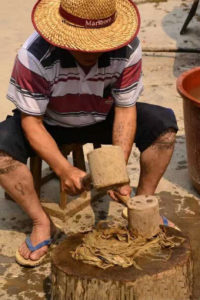
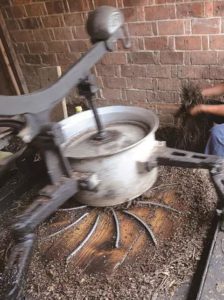
Step 4. Mix a tree sap called “huaye” with the pulp. The added sap serves as a natural viscous adhesive which can separate and bond molecules in pulps. Then pour this mixture into a large sink.
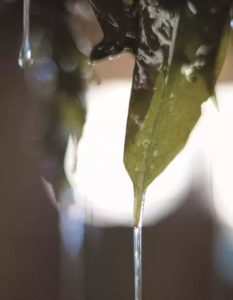
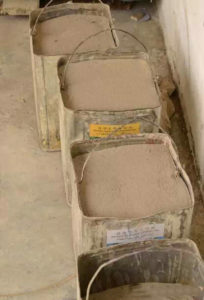
Step 5. Drain the mixture – essentially, now a dilute suspension of fibers in water – through a wooden screen. This will lay down a mat of randomly interwoven fibers. Filter and slowly separate the sheet of fibers.
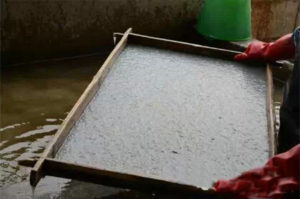
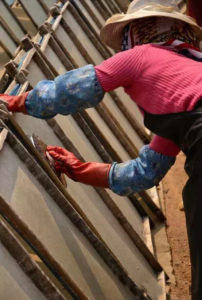
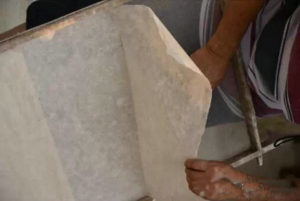
Step 6. After drying and ironing, a sheet of solid and durable paper is produced.
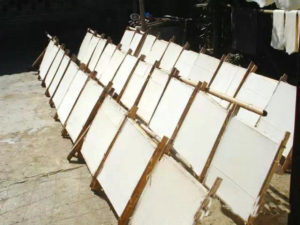
These papers have good air permeability and a pleasing woody aroma. They’re also bug-proof and damp-resistant. Some temples in Yunnan use them to transcribe religious scriptures, which can then be preserved for hundreds of years.
These qualities make them useful to wrap puer cakes, too. This novel idea was likely promoted by the Heqing Commercial Group, along the ancient tea-horse road and horse caravans in 1940s.
However, making paper by hand according to this ancient tradition is becoming increasingly expensive, as a result of rare wild paper mulberry resources, the large amount of wood needed in the cooking process, and other factors. Therefore, papers used nowadays to pack puer cakes are produced by machines. It’s also becoming popular to add dyed plant fiber to produce silver or golden threads embedded in the paper, for a more premium look.
Silver paper wrap
Cake-wrapping
This video shows the process of a staff wraps a puer cake.
Moso Bamboo Shells
Yunnan people also have a long history of utilizing bamboos. Early in history, the local tea farmers began employing the tough shells of bamboo shoots to pack puer tea, avoiding undesired factors such as moisture or sun exposure when transporting their tea.
Puer cakes are wrapped with clean bamboo shoot shells and tied with steel hoops (bamboo strips were used previously, instead of steel). Compared to machine-manufactured papers, the bamboo shoot shell wrap needs to be made by hand, which even the most proficient worker has to take one to two minutes.
Another step to show the all-naturale wrap is to clean bamboo shoot shells. Bamboo shoot shells with a useful shape and the least discoloration will usually be selected. As most bamboo shoot shells are picked from wild moso bamboos, one may be greeted with not-so-pleasant surprises of worm eggs or even one or two fat worms in vintage cakes! Thanks to ultraviolet sterilization in modern production, most factories have resolved this problem.
Does bamboo shoot shell wrapping enhance the taste of puer?
As bamboo shoot shells are hard, people used to immerse them in water before packing them with tea. This would soften them up. Then the puer tea would be packed inside, also getting a bit damp and softer. Tea within the bamboo shoot shell, as a result, contains lots of water, which turns out to accelerate the aging process. Wrapped in bamboo shoot shells, the cake barrel is quite similar to a slow cooker both in shape and in function. It basically forms an ecosystem – stable temperature, light-resist, and optimal air permeability, serving together as a hotbed for puer fermentation.
In 1970s and 1980s, bamboo shells did not meet export standards, being considered not “sanitary” enough. Thus most exported puer cakes have been packaged in individual paper boxes. Within China, however, many tea connoisseurs still prefer the bamboo shell packaging for their premium collection. Many agree that bamboo shell wrapped cakes tastes better in A/B testing, although relevant scientific studies have not been published.
This video shows the process of a staff wraps 7 cakes into a bamboo barrel.
Retold by Si Chen
Tea Market
Get More Value from Your Tea: BRU Maker One
+41794574278
Jacque's Organics
(647) 804-7263